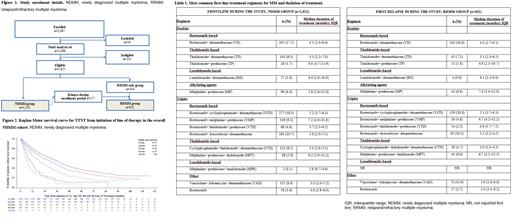Abstract
Introduction:
Multiple myeloma (MM) is a progressive, rarely curable, B-cell malignancy (McCachren et al. 2021). The incidence is increasing, with the greatest acceleration in emerging markets (Cowan et al. 2016). Optimal management amidst emerging treatments is challenging (Bruno et al. 2020; Mohty et al. 2020). This study aimed to obtain real-world data on treatment, toxicity and healthcare utilization in patients with MM in emerging markets.
Methods:
INTEGRATE is an international, multi-center, retrospective, observational study of the medical records of alive or deceased patients aged ≥18 years with newly diagnosed (NDMM) or relapsed/refractory (RRMM) disease between 1 January 2010 and 31 December 2011 (Figure 1). The primary objective was to describe the time to next treatment (TTNT) at each line of therapy.
Results:
Patient records were screened at 45 centers across Argentina, China, Republic of Korea, Russia, Saudi Arabia, South Africa, Taiwan and Turkey. In the NDMM group (N=1,511), patients were followed up for a median 56.9 months, 50.6% were male and predominantly White (50.2%) or Asian (37.9%). The mean age at diagnosis was 59.6 years (range 24.4-97.3 years). Most patients (51.4%) had immunoglobulin G (IgG) myeloma, and 32.0% had IgG kappa and were staged using International Staging System criteria (49.6%). Many patients had bone lesions in 1-3 sites (43.3%) and a majority had no fluorescence in situ hybridization data reported. There were 481 (31.8%) patients who underwent frontline stem-cell transplantation (SCT), of the 987 patients who did not, 121 (12.3%) were eligible for transplant.
In the RRMM group (N=621), patients were followed up for a median 62.2 months, 50.1% were male, 57.0% White and 32.2% Asian. The mean age at diagnosis was 57.9 years (range 17.7-86.4 years). Most patients (52.5%) had IgG myeloma, 33.5% had IgG kappa, and 44.1% had bone lesions in more than three sites. Of the 144 patients eligible for SCT at the relapsed/refractory diagnosis, 98 (68.1%) underwent transplantation.
The median time on first-line therapy was 6.0 months (interquartile range [IQR] 3.7-10.4), 6.4 months (IQR 3.2-11.9) at second line and 6.6 months (IQR 3.3-9.6) at third line for NDMM patients. In the RRMM group, the median time on first-line therapy was 5.7 months (IQR 3.5-9.0), 6.0 months (IQR 3.3-9.5) at second line and 6.0 months (IQR 3.1-10.9) at third line. The most common first-line therapies are shown in Table 1. The median TTNT for patients with NDMM was 39.5 months (95% confidence interval [CI] 37.6-42.6) at first line, 33.9 months (95% CI 28.8-37.0) at second line and 20.9 months (95% CI 17.1-27.1) at third line (Figure 2).
In the non-SCT NDMM subgroup, 44% of patients had documented relapse or disease progression after first-line treatment and the 5-year OS rate was 64.6% (95% CI 61.2-67.9). In the SCT NDMM subgroup, 43.2% of patients had documented relapse or progression after first-line treatment and the 5-year OS rate was 73.5% (95% CI 69.1-77.4). In a risk factor analysis, Asian ethnicity (p<0.001), bone marrow plasma cells at diagnosis (p<0.001), no SCT performed frontline for NDMM (p=0.001), ISS stage II/III and the presence of either t(4;14), t(14;16) or del 17p13 (p=0.022) were associated with shorter TTNT in the NDMM patients.
Conclusions:
INTEGRATE is the largest real-world study to describe the management of MM across these eight emerging markets that remains reflective of the treatments currently available in these countries. We found time on therapy not dissimilar to cohorts in Europe and the US (Mohty et al. 2020; Hari et al. 2018) although the real-world OS appears longer than previous reports from Japan (Akizuki et al. 2020) and the US (Bruno et al. 2020). In addition, median duration of treatment during the first 3 lines of therapy are also very similar to that reported by Kwee et al. 2016. The INTEGRATE study highlights a wide variation between the TTNT and duration of treatment and has the potential to inform screening and management decisions based on available treatments to maximize lines of therapy.
Kim: Janssen, BMS: Research Funding. Schutz: Takeda: Honoraria; Johnson & Johnson: Honoraria; Sanofi: Honoraria. Mitina: Takeda: Honoraria, Membership on an entity's Board of Directors or advisory committees. Chng: Novartis: Honoraria, Research Funding; Antengene: Honoraria; Pfizer: Honoraria; Sanofi: Honoraria; AbbVie: Honoraria; Amgen: Honoraria; BMS/Celgene: Honoraria, Research Funding; Johnson & Johnson: Honoraria, Research Funding; Takeda: Honoraria; Aslan: Research Funding. Wu: Takeda: Current Employment, Current equity holder in publicly-traded company. Wan: Takeda: Current Employment. Huang: Takeda: Current Employment, Current equity holder in publicly-traded company. Beksac: BMS: Membership on an entity's Board of Directors or advisory committees, Speakers Bureau; Janssen: Membership on an entity's Board of Directors or advisory committees, Speakers Bureau; Sanofi: Membership on an entity's Board of Directors or advisory committees, Speakers Bureau; Amgen: Membership on an entity's Board of Directors or advisory committees, Speakers Bureau; Oncopeptides: Membership on an entity's Board of Directors or advisory committees, Speakers Bureau; Takeda: Membership on an entity's Board of Directors or advisory committees, Speakers Bureau.


This feature is available to Subscribers Only
Sign In or Create an Account Close Modal